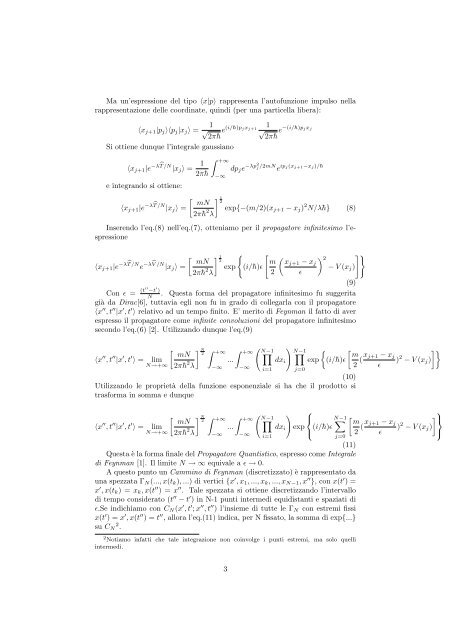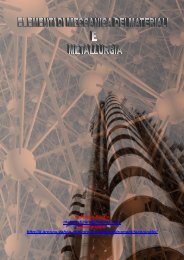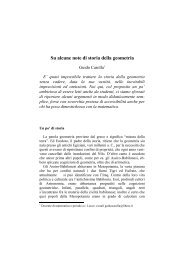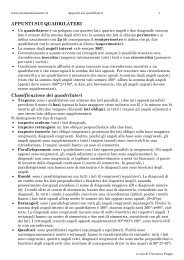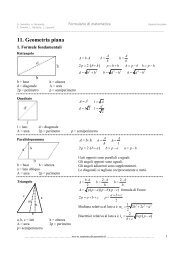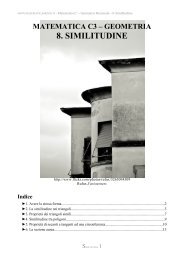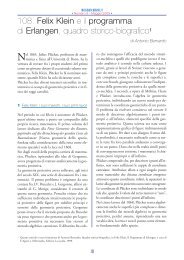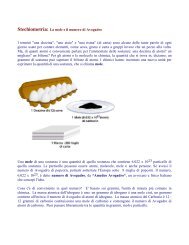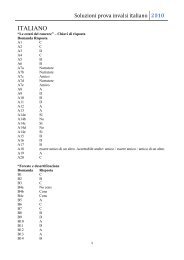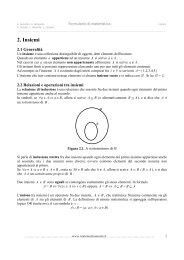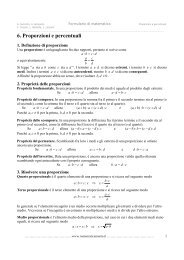Scarica la tesi Integrale di Feynman sui Cammini e Processi Stocastici
Scarica la tesi Integrale di Feynman sui Cammini e Processi Stocastici
Scarica la tesi Integrale di Feynman sui Cammini e Processi Stocastici
Create successful ePaper yourself
Turn your PDF publications into a flip-book with our unique Google optimized e-Paper software.
Ma un’espressione del tipo 〈x|p〉 rappresenta l’autofunzione impulso nel<strong>la</strong><br />
rappresentazione delle coor<strong>di</strong>nate, quin<strong>di</strong> (per una particel<strong>la</strong> libera):<br />
〈xj+1|pj〉〈pj|xj〉 = 1<br />
√ e<br />
2π¯h (i/¯h)pjxj+1 1<br />
√2π¯h e −(i/¯h)pjxj<br />
Si ottiene dunque l’integrale gaussiano<br />
〈xj+1|e −λT /N |xj〉 = 1<br />
2π¯h<br />
e integrando si ottiene:<br />
〈xj+1|e −λT /N |xj〉 =<br />
mN<br />
2π¯h 2 λ<br />
+∞<br />
−∞<br />
dpje −λp2<br />
j /2mN e ipj(xj+1−xj)/¯h<br />
1<br />
2<br />
exp{−(m/2)(xj+1 − xj) 2 N/λ¯h} (8)<br />
Inserendo l’eq.(8) nell’eq.(7), otteniamo per il propagatore infini<strong>tesi</strong>mo l’espressione<br />
〈xj+1|e −λT /N e −λV /N |xj〉 =<br />
1 <br />
2<br />
m<br />
exp (i/¯h)ɛ<br />
2<br />
<br />
mN<br />
2π¯h 2 λ<br />
<br />
2<br />
xj+1 − xj<br />
− V (xj)<br />
ɛ<br />
(9)<br />
Con ɛ = (t′′ −t ′ )<br />
. Questa forma del propagatore infini<strong>tesi</strong>mo fu suggerita<br />
N<br />
già da Dirac[6], tuttavia egli non fu in grado <strong>di</strong> collegar<strong>la</strong> con il propagatore<br />
〈x ′′ , t ′′ |x ′ , t ′ 〉 re<strong>la</strong>tivo ad un tempo finito. E’ merito <strong>di</strong> <strong>Feynman</strong> il fatto <strong>di</strong> aver<br />
espresso il propagatore come infinite convoluzioni del propagatore infini<strong>tesi</strong>mo<br />
secondo l’eq.(6) [2]. Utilizzando dunque l’eq.(9)<br />
〈x ′′ , t ′′ |x ′ , t ′ <br />
mN<br />
〉 = lim<br />
N→+∞ 2π¯h 2 N<br />
2<br />
λ<br />
+∞<br />
...<br />
−∞<br />
+∞<br />
−∞<br />
<br />
N−1 <br />
i=1<br />
dxi<br />
<br />
N−1 <br />
j=0<br />
<br />
m<br />
exp (i/¯h)ɛ<br />
(10)<br />
Utilizzando le proprietà del<strong>la</strong> funzione esponenziale si ha che il prodotto si<br />
trasforma in somma e dunque<br />
〈x ′′ , t ′′ |x ′ , t ′ <br />
mN<br />
〉 = lim<br />
N→+∞ 2π¯h 2 N<br />
2<br />
λ<br />
+∞<br />
...<br />
−∞<br />
+∞<br />
−∞<br />
⎧<br />
N−1 ⎨<br />
dxi exp<br />
⎩ (i/¯h)ɛ<br />
N−1 <br />
<br />
m<br />
(11)<br />
Questa è <strong>la</strong> forma finale del Propagatore Quantistico, espresso come <strong>Integrale</strong><br />
<strong>di</strong> <strong>Feynman</strong> [1]. Il limite N → ∞ equivale a ɛ → 0.<br />
A questo punto un Cammino <strong>di</strong> <strong>Feynman</strong> (<strong>di</strong>scretizzato) è rappresentato da<br />
una spezzata ΓN(..., x(tk), ...) <strong>di</strong> vertici {x ′ , x1, ..., xk, ..., xN−1, x ′′ }, con x(t ′ ) =<br />
x ′ , x(tk) = xk, x(t ′′ ) = x ′′ . Tale spezzata si ottiene <strong>di</strong>scretizzando l’intervallo<br />
<strong>di</strong> tempo considerato (t ′′ − t ′ ) in N-1 punti interme<strong>di</strong> equi<strong>di</strong>stanti e spaziati <strong>di</strong><br />
ɛ.Se in<strong>di</strong>chiamo con CN (x ′ , t ′ ; x ′′ , t ′′ ) l’insieme <strong>di</strong> tutte le ΓN con estremi fissi<br />
x(t ′ ) = x ′ , x(t ′′ ) = t ′′ , allora l’eq.(11) in<strong>di</strong>ca, per N fissato, <strong>la</strong> somma <strong>di</strong> exp{...}<br />
su CN 2 .<br />
2 Notiamo infatti che tale integrazione non coinvolge i punti estremi, ma solo quelli<br />
interme<strong>di</strong>.<br />
3<br />
i=1<br />
j=0<br />
2 (xj+1 − xj<br />
)<br />
ɛ<br />
2 − V (xj)<br />
2 (xj+1 − xj<br />
)<br />
ɛ<br />
2 − V (xj)<br />
<br />
⎫ ⎬<br />
⎭


